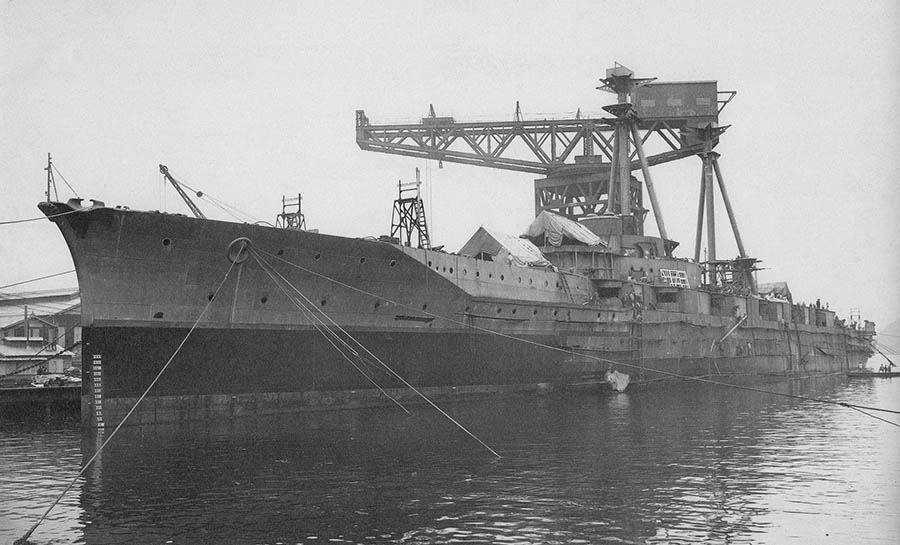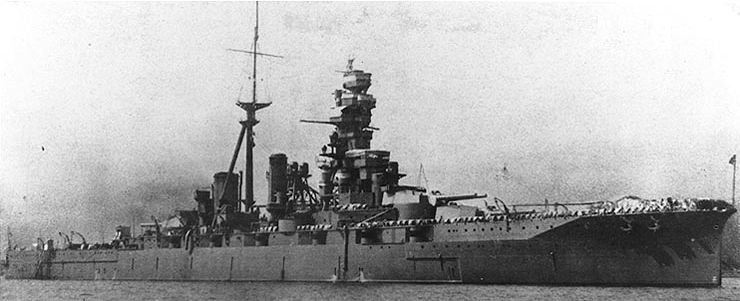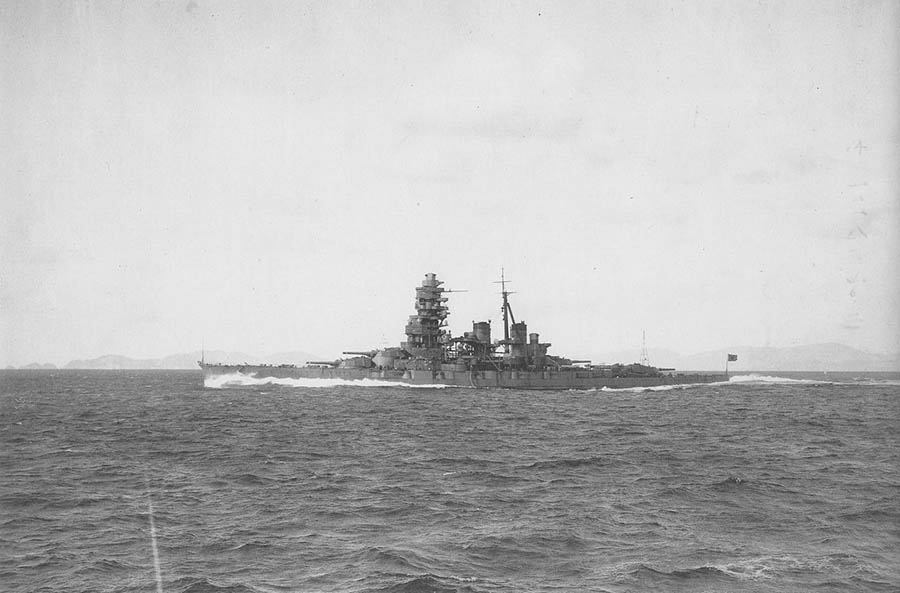F
Fredrocker
Guest
Designed by British naval architect George Thurston, she was the second launched of four Kongō-class battlecruisers, among the most heavily armed ships in any navy when built. Laid down in 1911 at the Yokosuka Naval Arsenal, Hiei was formally commissioned in 1914. She patrolled off the Chinese coast on several occasions during World War I, and helped with rescue efforts following the 1923 Great Kantō earthquake.

Starting in 1929, Hiei was converted to a gunnery training ship to avoid being scrapped under the terms of the Washington Naval Treaty. She served as Emperor Hirohito's transport in the mid-1930s. Starting in 1937, she underwent a full-scale reconstruction that completely rebuilt her superstructure, upgraded her powerplant, and equipped her withlaunch catapults for floatplanes. Now fast enough to accompany Japan's growing fleet of aircraft carriers, she was reclassified as a fast battleship. On the eve of the US entry into World War II, she sailed as part of Vice-Admiral Chuichi Nagumo's Combined Fleet, escorting the six carriers that attacked Pearl Harbor on 7 December 1941.
To avoid having to scrap Hiei under the terms of the Washington Treaty, the Imperial Japanese Navy decided to convert her into a demilitarized training ship. On 15 October 1929, she went into drydock at Kure Naval Arsenal. Her aft 14-inch gun turrets were removed, and she was stripped of all eight of her submerged torpedo tubes, as well as her 6-inch guns and armor belt. All but nine of her boilers were taken out, reducing her speed to 18 knots (33 km/h), and one of her three funnels was removed. She was reclassified as a reserve ship at the end of November 1929. On 24 April 1930, reconstruction was halted due to the signing of the London Naval Treaty, which further restricted battleship construction and possession amongst the great naval powers, and preservation work was begun at Sasebo. Reconstruction would not resume until July 1931.

In September 1931, Japanese army units invaded the Chinese province of Manchuria, transforming it into the puppet state of Manchukuo. In December 1932, Hiei was reassigned to the Imperial Japanese Navy's training squadron. On 25 February, the League of Nations ruled that Japan had violated Chinese sovereignty and international law in her invasion of Manchuria. Refusing to accept the League's judgment, the Empire of Japan withdrew from the League the same day. This also signaled its exit from the Washington and London Naval Treaties, which removed all restrictions on the Imperial Japanese Navy's construction of capital ships. From the end of May 1933 to 13 August, Hiei received upgrades that allowed her to perform regular duties for the Emperor, and she served as the Emperor's observation ship for the Imperial Naval Review three days later. From January to March 1934, her No. 4 turret and ammunition magazine were refitted. In November 1935, Hiei served as the Emperor's ship for his official visit to the Kagoshima and Miyazaki Prefectures.
On 17 January 1942, Hiei departed Truk Lagoon Naval Base with the Third Battleship Division to support carrier operations against Rabaul and Kavieng. In February, she deployed alongside a force of carriers and destroyers in response to American raids on Japanese bases in the Gilbert and Marshall Islands.On 1 March, following carrier operations against Darwin and Java, Hiei, Kirishima and Chikuma—which were acting as escorts for the carrier task force—engaged the destroyer USS Edsall, with Hiei firing 210 14-inch and seventy 6-inch shells. When the ships failed to score any hits, dive-bombers from three of Admiral Nagumo's carriers immobilized the destroyer, which was then sunk by gunfire from the three ships.
In April 1942, Hiei and the Third Battleship Division joined five fleet carriers and two cruisers in a massive raid against British naval forces in the Indian Ocean. On 5 April—Easter Sunday—the Japanese fleet attacked the harbor at Colombo, Ceylon while seaplanes from the cruiser Tone spotted two fleeing British cruisers, both of which were later sunk by aerial attack. On 8 April, Japanese carrier aircraft attacked the Royal Navy base at Trincomalee, only to find that all of Admiral James Somerville's remaining warships in the British Eastern Fleet had withdrawn the previous night. Returning from the attack, a floatplane from Hiei's sister shipHaruna spotted the aircraft carrier HMS Hermes, which was quickly sunk by massive aerial attack. The fleet then returned to Japan, arriving at the home bases on 23 April.

On 27 May 1942, Hiei sortied with Kongō and the heavy cruisers Atago, Chōkai, Myōkō, and Haguro as part of Admiral Nobutake Kondō's Invasion Force during the Battle of Midway. Following the disastrous loss of four of the Combined Fleet's fast carriers on 4 June, Kondō's force withdrew to Japan. In July, Hiei was drydocked for refits to her aircraft complement and the addition of single and twin 25 mm gun mounts. In August, she escorted the Japanese carrier Shōkaku during the Battle of the Eastern Solomons In October, Hiei sortied as part of Rear Admiral Abe's Vanguard Force, and maintained distant cover as Kongō and Haruna nearly destroyed Henderson Fieldon Guadalcanal on the night of 13 October. From 26–30 October, Hiei and her sisters participated in the Battle of the Santa Cruz Islands.
A damaged Hiei, trailing oil, is attacked by US Army B-17s, 13 November 1942
On 10 November 1942, Hiei departed Truk alongside Kirishima and eleven destroyers in preparation to shell American positions near Henderson Field in advance of a major convoy of Japanese troops. Under the command of Rear Admiral Hiroaki Abe, the force was spotted by US Navy reconnaissance aircraft several days in advance. A force of two heavy cruisers, three light cruisers and eight destroyers was deployed under the command of Rear Admiral Daniel J. Callaghan in Ironbottom Sound to meet them. At 01:24 on 13 November, the Japanese force was detected 28,000 yards (26 km) out by the light cruiser USS Helena. Because Abe had not anticipated resistance, his battleships' main guns were loaded with high-explosive shells for bombarding Henderson Field, and thus they were unable to open fire immediately while the switch was made to armor-piercing shells.At 01:50, Hiei activated her searchlights and opened fire on the light cruiser USS Atlanta, commencing the First Naval Battle of Guadalcanal. Though Atlanta's guns succeeded in disabling the searchlight, Hiei was able to concentrate her main batteries on the bridge, crippling the light cruiser and killing Rear Admiral Norman Scott. Hiei and Kirishima then disabled two American destroyers (one of which later sank). In turn, Hieibecame the target of the majority of the American firepower, with the American 5-inch guns inflicting severe damage on Hiei's superstructure at close range; Admiral Abe himself was later injured after USS Laffey shelled the bridge with her own guns, killing his chief of staff, Captain Suzuki Masakane. This concentration enabled Kirishima to evade the American barrage and cripple USS San Francisco, killing Admiral Callaghan. However, shells from San Francisco disabled Hiei's steering machinery.

With one of his battleships crippled, Abe ordered the remainder of the Japanese fleet to withdraw at 02:00. Kirishima attempted to tow Hiei to safety, but water flooded her steering compartments, jamming her rudder to starboard. Throughout the morning of 14 November, Hiei was subjected to attack from American Army B-17 Flying Fortress bombers. She continued circling starboard at 5 knots (5.8 mph). At 11:30, two torpedoes launched from Grumman TBF Avenger torpedo-bombers struck Hiei. After suffering several more torpedo and dive-bomber attacks throughout the day, the order was given for her crew to abandon ship before her escorting destroyers scuttled her. Hiei sank sometime in the evening on 14 November with the loss of 188 of her crew, the first battleship ever lost in action by Japan. She was removed from the Navy List on 20 December 1942.

Starting in 1929, Hiei was converted to a gunnery training ship to avoid being scrapped under the terms of the Washington Naval Treaty. She served as Emperor Hirohito's transport in the mid-1930s. Starting in 1937, she underwent a full-scale reconstruction that completely rebuilt her superstructure, upgraded her powerplant, and equipped her withlaunch catapults for floatplanes. Now fast enough to accompany Japan's growing fleet of aircraft carriers, she was reclassified as a fast battleship. On the eve of the US entry into World War II, she sailed as part of Vice-Admiral Chuichi Nagumo's Combined Fleet, escorting the six carriers that attacked Pearl Harbor on 7 December 1941.
To avoid having to scrap Hiei under the terms of the Washington Treaty, the Imperial Japanese Navy decided to convert her into a demilitarized training ship. On 15 October 1929, she went into drydock at Kure Naval Arsenal. Her aft 14-inch gun turrets were removed, and she was stripped of all eight of her submerged torpedo tubes, as well as her 6-inch guns and armor belt. All but nine of her boilers were taken out, reducing her speed to 18 knots (33 km/h), and one of her three funnels was removed. She was reclassified as a reserve ship at the end of November 1929. On 24 April 1930, reconstruction was halted due to the signing of the London Naval Treaty, which further restricted battleship construction and possession amongst the great naval powers, and preservation work was begun at Sasebo. Reconstruction would not resume until July 1931.

In September 1931, Japanese army units invaded the Chinese province of Manchuria, transforming it into the puppet state of Manchukuo. In December 1932, Hiei was reassigned to the Imperial Japanese Navy's training squadron. On 25 February, the League of Nations ruled that Japan had violated Chinese sovereignty and international law in her invasion of Manchuria. Refusing to accept the League's judgment, the Empire of Japan withdrew from the League the same day. This also signaled its exit from the Washington and London Naval Treaties, which removed all restrictions on the Imperial Japanese Navy's construction of capital ships. From the end of May 1933 to 13 August, Hiei received upgrades that allowed her to perform regular duties for the Emperor, and she served as the Emperor's observation ship for the Imperial Naval Review three days later. From January to March 1934, her No. 4 turret and ammunition magazine were refitted. In November 1935, Hiei served as the Emperor's ship for his official visit to the Kagoshima and Miyazaki Prefectures.
On 17 January 1942, Hiei departed Truk Lagoon Naval Base with the Third Battleship Division to support carrier operations against Rabaul and Kavieng. In February, she deployed alongside a force of carriers and destroyers in response to American raids on Japanese bases in the Gilbert and Marshall Islands.On 1 March, following carrier operations against Darwin and Java, Hiei, Kirishima and Chikuma—which were acting as escorts for the carrier task force—engaged the destroyer USS Edsall, with Hiei firing 210 14-inch and seventy 6-inch shells. When the ships failed to score any hits, dive-bombers from three of Admiral Nagumo's carriers immobilized the destroyer, which was then sunk by gunfire from the three ships.
In April 1942, Hiei and the Third Battleship Division joined five fleet carriers and two cruisers in a massive raid against British naval forces in the Indian Ocean. On 5 April—Easter Sunday—the Japanese fleet attacked the harbor at Colombo, Ceylon while seaplanes from the cruiser Tone spotted two fleeing British cruisers, both of which were later sunk by aerial attack. On 8 April, Japanese carrier aircraft attacked the Royal Navy base at Trincomalee, only to find that all of Admiral James Somerville's remaining warships in the British Eastern Fleet had withdrawn the previous night. Returning from the attack, a floatplane from Hiei's sister shipHaruna spotted the aircraft carrier HMS Hermes, which was quickly sunk by massive aerial attack. The fleet then returned to Japan, arriving at the home bases on 23 April.

On 27 May 1942, Hiei sortied with Kongō and the heavy cruisers Atago, Chōkai, Myōkō, and Haguro as part of Admiral Nobutake Kondō's Invasion Force during the Battle of Midway. Following the disastrous loss of four of the Combined Fleet's fast carriers on 4 June, Kondō's force withdrew to Japan. In July, Hiei was drydocked for refits to her aircraft complement and the addition of single and twin 25 mm gun mounts. In August, she escorted the Japanese carrier Shōkaku during the Battle of the Eastern Solomons In October, Hiei sortied as part of Rear Admiral Abe's Vanguard Force, and maintained distant cover as Kongō and Haruna nearly destroyed Henderson Fieldon Guadalcanal on the night of 13 October. From 26–30 October, Hiei and her sisters participated in the Battle of the Santa Cruz Islands.
A damaged Hiei, trailing oil, is attacked by US Army B-17s, 13 November 1942
On 10 November 1942, Hiei departed Truk alongside Kirishima and eleven destroyers in preparation to shell American positions near Henderson Field in advance of a major convoy of Japanese troops. Under the command of Rear Admiral Hiroaki Abe, the force was spotted by US Navy reconnaissance aircraft several days in advance. A force of two heavy cruisers, three light cruisers and eight destroyers was deployed under the command of Rear Admiral Daniel J. Callaghan in Ironbottom Sound to meet them. At 01:24 on 13 November, the Japanese force was detected 28,000 yards (26 km) out by the light cruiser USS Helena. Because Abe had not anticipated resistance, his battleships' main guns were loaded with high-explosive shells for bombarding Henderson Field, and thus they were unable to open fire immediately while the switch was made to armor-piercing shells.At 01:50, Hiei activated her searchlights and opened fire on the light cruiser USS Atlanta, commencing the First Naval Battle of Guadalcanal. Though Atlanta's guns succeeded in disabling the searchlight, Hiei was able to concentrate her main batteries on the bridge, crippling the light cruiser and killing Rear Admiral Norman Scott. Hiei and Kirishima then disabled two American destroyers (one of which later sank). In turn, Hieibecame the target of the majority of the American firepower, with the American 5-inch guns inflicting severe damage on Hiei's superstructure at close range; Admiral Abe himself was later injured after USS Laffey shelled the bridge with her own guns, killing his chief of staff, Captain Suzuki Masakane. This concentration enabled Kirishima to evade the American barrage and cripple USS San Francisco, killing Admiral Callaghan. However, shells from San Francisco disabled Hiei's steering machinery.

With one of his battleships crippled, Abe ordered the remainder of the Japanese fleet to withdraw at 02:00. Kirishima attempted to tow Hiei to safety, but water flooded her steering compartments, jamming her rudder to starboard. Throughout the morning of 14 November, Hiei was subjected to attack from American Army B-17 Flying Fortress bombers. She continued circling starboard at 5 knots (5.8 mph). At 11:30, two torpedoes launched from Grumman TBF Avenger torpedo-bombers struck Hiei. After suffering several more torpedo and dive-bomber attacks throughout the day, the order was given for her crew to abandon ship before her escorting destroyers scuttled her. Hiei sank sometime in the evening on 14 November with the loss of 188 of her crew, the first battleship ever lost in action by Japan. She was removed from the Navy List on 20 December 1942.


